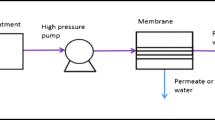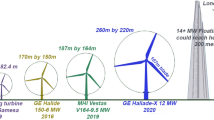Abstract
Pump operating as turbine (PAT) is an effective source of reducing the equipment cost in small hydropower plants. However, the manufacturers provide poor information on the PAT performance thus representing a limit for its wider diffusion. Additional implementation difficulties arise under variable operating conditions, characteristic of water distribution networks (WDNs). WDNs allow to obtain widespread and globally significant amount of produced energy by exploiting the head drop due to the network pressure control strategy for leak reductions. Thus a design procedure is proposed that couples a parallel hydraulic circuit with an overall plant efficiency criteria for the market pump selection within a WDN. The proposed design method allows to identify the performance curves of the PAT that maximizes the produced energy for an assigned flow and pressure-head distribution pattern. Finally, computational fluid dynamics (CFD) is shown as a suitable alternative for performance curve assessment covering the limited number of experimental data.








Similar content being viewed by others
References
Afshar A, Jemaa F, Marino M (1990) Optimization of hydropower plant integration in water supply system. J Water Res Pl-ASCE 116(5):665–675
Alatorre-Frenk C, Thomas T (1990) The pumps as turbines approach to small hydropower. In: World congress on renewable energy, Reading
Almandoz J, Cabrera E, Arregui F, Cabrera E, Cobacho R (2005) Leakage assessment through water distribution network simulation. J Water Res Pl-ASCE 131(6):458–466
Araujo L, Ramos H, Coelho S (2006) Pressure control for leakage minimisation in water distribution systems management. Water Resour Manage 20(1):133–149
Arriaga M (2010) Pump as turbine—a pico-hydro alternative in Lao people’s democratic republic. Renew Energy 35:1109–1115
Carravetta A, Giugni M (2009) Functionality factors in the management and rehabilitation of water networks. In: Management of water networks, proc conf efficient management of water networks. Design and Rehabilitation Techniques, Franco Angeli Ed. Milano
Carravetta A, Fecarotta O, Ramos H (2011) Numerical simulation on pump as turbine: mesh reliability and performance concerns. In: IEEE (ed) international conference on clean electrical power. Ischia, Franco Angeli Ed. Milano
Chapallaz J, Eichenberger P, Fischer G (1992) Manual on pumps used as turbines. DeutschesZentru fur Entwicklungstechnologien, GATE, Eschborn
Childs S (1962) Convert pumps to turbines and recover HP. Hydrocarbon Processing and Petroleum Refiner 41(10):173–174
Derakhshan S, Nourbakhsh A (2008a) Experimental study of characteristic curves of centrifugal pumps working as turbines in different specific speeds. Exp Therm Fluid Sci 32:800–807
Fecarotta O, Carravetta A, Ramos H (2011) CFD and comparisons for a pump as turbine: mesh reliability and performance concerns. Int J Energy Environ 2(1):39–48
Fernandez J, Blanco E, Parrondo J, Stickland M, Scanlon T (2004) Performance of a centrifugal pump running in inverse mode. Proc Inst Mech Eng A J power energy 218(4):265–271
Filion Y, MacLean H, Karney B (2004) Life cycle energy analysis of a water distribution system. J Infrastruct Syst 10(3):120–130
Fontana N, Giugni M, Portolano D (2012) Losses reduction and energy production in water-distribution networks. J Water Res Pl-ASCE 138(3):237–244
Gantar M (1988) Propeller, pump running as turbines. In: Conference on hydraulic machinery
Gonçalves F, Costa L, Ramos H (2011) ANN for hybrid energy system evaluation: methodology and WSS case study. Water Resour Manage 25:2295–2317
Grover K (1980) Conversion of pumps to turbines. In: GSA Inter corp. Katonah, New York
Hanckock J (1963) Centrifugal pump or water turbine. Pipe Line News, 25–27
Karadirek I, Kara S, Yilmaz G, Muhammetoglu A, Muhammetoglu H (2011) Implementation of hydraulic modelling for water-loss reduction through pressure management. Water Resour Manage. doi:10.1007/s11269-012-0032-2
Kerschberger P, Gehrer A (2010) Hydraulic development of high specific-speed Pump-turbines by means of an inverse design method, numerical flowsimulation (CFD) and model testing. In: 25th IAHR symposium on hydraulic machinery and systems. IOP Conf. Series: Earth and Environmental Science, vol 12
Liberatore s, Sechi G (2009) Location and calibration of valves in water distribution networks using a scatter-search meta-heuristic approach. Water Resour Manage 23:1479–1495
Natanasabapathi S, Kshirsagar J (2004) Pump as turbine: an experience with CFX-5.6. In: Corporate research and engineering division. Pune, India, Kirloskar Bros. Ltd
Nautiyal H, Varun, Kumar A (2010a) CFD analysis on pumps working as turbines. Hydro Nepal, vol 6, 35–37
Nautiyal H, Varun, Kumar A (2010b) Reverse running pumps analytical, experimental and computational study: a review. Renew Sustain Energy Rev 14:2059–2067
Nazif S, Karamouz M, Tabesh M, Moridi A (2011) Pressure management model for urban water distribution networks. Water Resour Manage 24:437–458
Prescott S, Ulanicki B (2008) Improved control of pressure reducing valves in water distribution networks. J Hydraul Eng-ASCE 134(1):56–65
Ramos H, Almeida A (2001) Dynamic orifice model on waterhammer analysis of high or medium heads of small hydropower plants. J Hydraul Res 39(4):429–436
Ramos H, Almeida A (2002) Parametric analysis of water-hammer effects in small hydro schemes. J Hydraul Eng-ASCE 128(7):1–8
Ramos H (2000) Guidelines for design of small hydropower plants. WREAN and DED, Belfast, North Ireland
Ramos H, Covas D, Araujo L, Mello M (2005) Available energy assessment in water supply systems. In: XXXI IAHR congress. Seoul, Korea
Ramos H, Mello M, De P (2010) Clean power in water supply systems as a sustainable solution: from planning to practical implementation. Water Sci Technol 10(1):39–49
Rodrigues A, Singh P, Williams A, Nestmann F, Lai E (2003) Hydraulic analysis of a pump as a turbine with CFD and experimental data. In: IMechE seminar computational fluid dynamics for fluid machinery
Schmiedl E (1988) Serien-Kreiselpumpentagung. Karlsruhe
Sharma K (1985) Small hydroelectric projects—use of centrifugal pumps as turbines. In: Kirloskar Electric o. Bangalore, India
Singh P, Nestmann F (2010) An optimization routine on a prediction and selection model for the turbine operation of centrifugal pumps. Exp Therm Fluid Sci 34(2):152–164
Stepanoff A (1957) Centrifugal and axial flow pumps. John Wiley, New York
Suter P (1966) Representation of pump characteristics for calculation of water hammer. Sulzer Tech Rev 4:45–48
Tucciarelli T, Criminisi A, Termini D (1999) Leak analysis in pipeline systems by means of optimal valve regulation. J Hydraul Eng-ASCE 125(3):277–285
Vairavamoorthy K, Lumbers J (1998) Leakage reduction in water distribution systems: optimal valve control. J Hydraul Eng-ASCE 124(11):1146–1154
Walsky T, Bezts W, Posluzny E, Weir M, Withman B (2006) Modeling leakage reduction through pressure control. J Am Water Works Ass, pp 148–155
Williams A (1994) The turbine performance of centrifugal pumps: a comparison of predictione methods. Proc Inst Mech Eng A J power energy 208(1):59–66
Wylie E, Streeter V and Suo L (1993) Fluid transient in systems. Prentice Hall, Englewood Cliffs, NJ 7632
Acknowledgements
The authors would like to thank Caprari s.p.a. and Eng. Lauro Antipodi for having provided both the experimental performance curves and the 3D-geometry of the two machines.
Author information
Authors and Affiliations
Corresponding author
Appendix
Appendix
In 1966 Suter introduced two parameters (see also Wylie et al. 1993):
where
represents the operating condition of the machine and
Being T the torque applied to the runner. The two functions WH(θ) and WT(θ) are unique for similar machines. Thus, once they are available for a prototype machine, they can be used to calculate the head drop H T and the efficiency η T of similar PATs in any operating condition θ
where \(\eta_B^T\) is the efficiency of the machine at the BEP. In Fig. 9 the Suter parameters of the machines A and B are shown for the turbine operating mode.
Rights and permissions
About this article
Cite this article
Carravetta, A., Del Giudice, G., Fecarotta, O. et al. Energy Production in Water Distribution Networks: A PAT Design Strategy. Water Resour Manage 26, 3947–3959 (2012). https://doi.org/10.1007/s11269-012-0114-1
Received:
Accepted:
Published:
Issue Date:
DOI: https://doi.org/10.1007/s11269-012-0114-1





